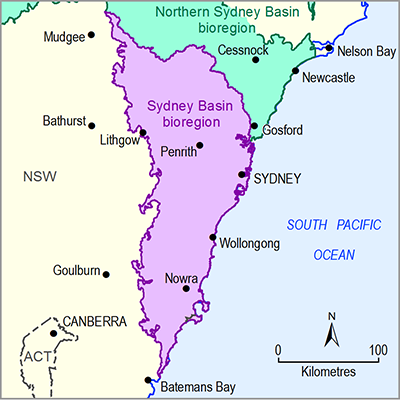- Home
- Assessments
- Bioregional Assessment Program
- Sydney Basin bioregion
- 1.1 Context statement for the Sydney Basin bioregion
- 1.1.4 Hydrogeology and groundwater quality
Summary
The southern part of the geological Sydney Basin is primarily a Permian-Triassic sedimentary rock sequence underlain by undifferentiated sedimentary rocks of Carboniferous and Devonian age. Locally there are important aquifers within the Hawkesbury Sandstone and Narrabeen Group and unconsolidated alluvial aquifers associated with present-day drainage networks and coastal deposits.
Alluvial deposits occur along the valleys, creeks and floodplains of the Nepean, Hawkesbury, Georges and Shoalhaven rivers in the bioregion. These deposits are generally shallow, forming unconfined aquifers that are responsive to rainfall and streamflow. Water movement in these deposits occurs as intergranular flow through the preferential pathways provided by interconnected, higher permeability sand and gravel lenses. Groundwater recharge to the alluvial aquifers is primarily from rainfall, with minor contributions from irrigation, leaky service mains and flow from the underlying bedrock units.
Late Triassic Wianamatta Group occurs as scattered remnant areas in the Southern Highlands, with major outcrops predominantly over the Cumberland Plain west of Sydney. The aquifer system comprises residual soils, colluvium and fine-grained rocks derived from shales, floodplain alluvium and weathered saprolite. Aquifers in the Wianamatta Group generally contain highly saline groundwater and have very low yields.
The Hawkesbury Sandstone occurs across the entire geological Sydney Basin, extending from the Southern Highlands to the Putty area in the north, and to the lower Blue Mountains. The Hawkesbury Sandstone comprises friable, fine- to coarse-grained, mature and well-sorted quartzose sandstone with some shale lenses of limited areal extent, resulting in localised aquitards. Water quality within the upper sections of the Hawkesbury Sandstone is commonly poorer than the lower sections due to leakage from overlying shale formations. Possible upward flow or migration of brackish to saline groundwater along fractures from underlying Narrabeen Group aquifers or Permian coal measures may be contributing to brackish conditions in the deeper Hawkesbury Sandstone on the eastern side of the Lapstone Structural Complex.
The aquifers of the Narrabeen Group, Bulgo and Scarborough sandstones, as well as the Bald Hill Claystone, outcrop in the valleys of the Cordeaux and Avon reservoirs, around the Southern Coalfields. Water quality in the Narrabeen Group is poorer than in the Hawkesbury Sandstone, with levels of total dissolved solids (TDS) (salinities) ranging from around 1500 to 5000 mg/L TDS.
The horizontally layered sandstone strata in the southern part of the geological Sydney Basin, which host the main aquifer systems, show particular features (e.g. dual/secondary porosity, fracturing and bedding plane shearing) related to local stress relief effects and large-scale deformation. The main role of groundwater in the Southern Coalfield is to support streams through baseflow and groundwater-dependent ecosystems, with both the Hawkesbury and Bulgo sandstone aquifers providing most of the baseflow.
The NSW Government undertakes groundwater planning and management via water sharing plans, allowing the management of individual groundwater systems. Water source areas of two existing and three proposed water sharing plans intersect the Sydney Basin bioregion. Groundwater extractions from these water sources areas are used for a range of purposes including domestic, stock, irrigation, town water supply and industrial purposes, with a proportion of water protected for the environment.

